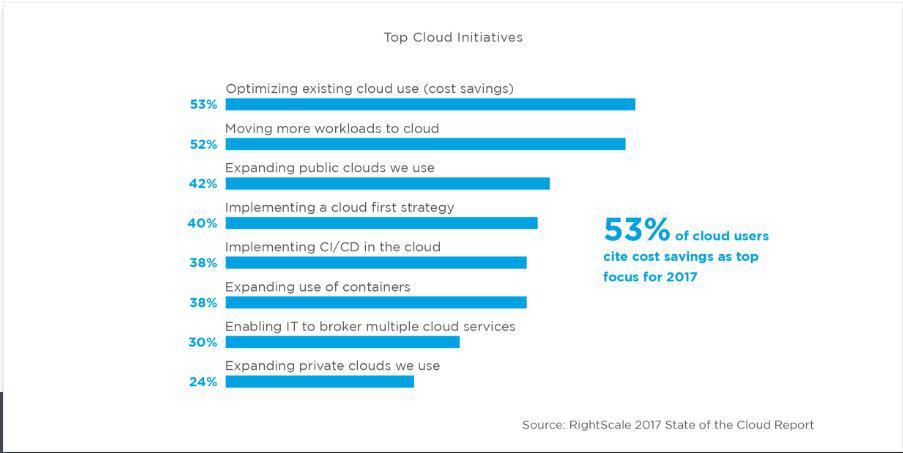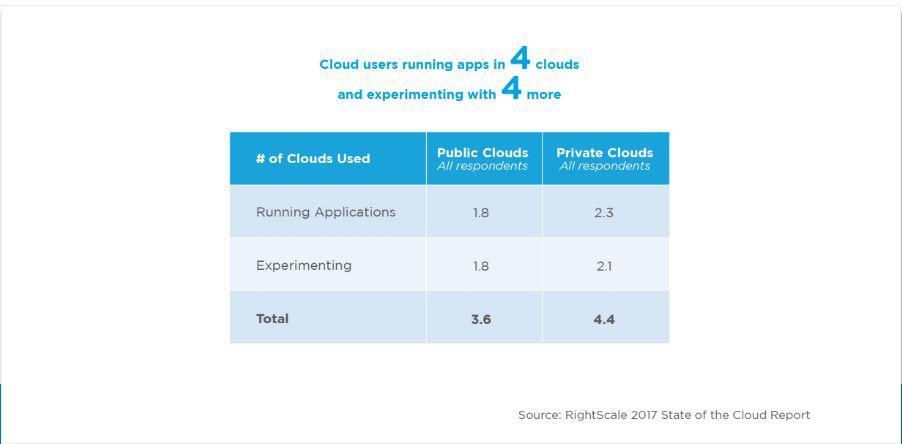Businesses increasingly opt for hybrid cloud solutions, with 58 percent selecting hybrid cloud and 85 percent multi cloud instead of a single private or public cloud, a survey by RightScale reveals. Amazon Web Services leads the way among public cloud solution providers but its market share remained flat at 57 percent last year. Azure’s market share rose 14 percent last year and now powers 34 percent of the public cloud. Google Cloud gained 5 percent during 2015 and its market share stands at 15 percent in 2017, according to the report.
RightScale’s annual State of the Cloud reports asks 1002 tech pros across multiple industries and company sizes to share information and insights on their cloud usage. The most evident conclusion of the report is that companies tend to choose multiple clouds, allowing Azure to gain market share while Amazon retains its market share.

Moreover, a growing number of businesses opt for public only options, with cloud users running applications in average on 1.8 public clouds and 2.3 private clouds. Overall, 41 percent of workloads run in the public cloud and 38 percent in the private cloud. Nearly half of the business respondents, 41 percent, are not keen to delegate authority to central IT for public clouds.
Managing costs is the biggest challenge cloud adopters face. Some 24 percent of mature cloud users reveal they cannot cope with cloud cost management while implementing cost savings initiatives is a top priority for 53 percent of respondents. A striking conclusion of the report is that over a third of businesses’ spend is wasted.
Nearly half the businesses are looking to expand their public cloud usage and implement a cloud first strategy in 2017. Implementation of CI/CD in the cloud and increased use of Containers is cited as cloud priority by 38 percent of businesses. About a third, 30 percent, of businesses plan to enable IT to broker multiple cloud services in 2017 and 24 percent mull expansion of the private cloud they use.
Among those who use devops tools, 35 percent have adopted Docker, compared to 27 percent in 2016.

Chef and Puppet lost some 4 percent each, their market shares dropping from 32 to 28 percent in 2017. Ansible is flat at 21 percent and Kubernetes doubled their adoption share from 7 to 14 percent worldwide.
hybrid cloud solutions look set to dominate the business cloud ecosystem in the next few years and no major shifts in market share among the top three platforms are to be expected. Nonetheless, Azure and Google Cloud adoption will grow thanks to the growing popularity of multi-platform cloud solutions where enterprises run their apps in up to four clouds.

Moreover, a growing number of businesses opt for public only options, with cloud users running applications in an average on 1.8 public clouds and 2.3 private clouds. Overall, 41 percent of workloads run in the public cloud and 38 percent in the private cloud. Nearly half of the business respondents, 41 percent, are not keen to delegate authority to central IT for public clouds.
Managing costs is the biggest challenge cloud adopters face. Some 24 percent of mature cloud users reveal they cannot cope with cloud cost management while implementing cost savings initiatives is a top priority for 53 percent of respondents. A striking conclusion of the report is that over a third of businesses’ spend is wasted.
By Kiril V. Kirilov





